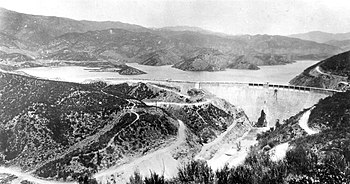St. Francis Dam
| St. Francis Dam | |
|---|---|

View of the dam looking north, with water in its reservoir (February 1927)
|
|
| Location | Los Angeles County, California, United States |
| Coordinates | 34°32′49″N 118°30′45″W / 34.54694°N 118.51250°WCoordinates: 34°32′49″N 118°30′45″W / 34.54694°N 118.51250°W |
| Construction began | 1924 |
| Opening date | 1926 |
| Demolition date | 1929 |
| Dam and spillways | |
| Impounds |
Los Angeles Aqueduct San Francisquito Creek |
| Height | 185 feet (56 m) |
| Height (foundation) | 205 feet (62 m) |
| Length | main dam 700 feet (210 m) wing dike 588 feet (179 m) |
| Elevation at crest | parapet 1838 feet (560.2m) spillway 1835 feet (559.3m) |
| Width (crest) | 16 feet (4.9 m) |
| Width (base) | 170 feet (52 m) |
| Parapet width | 16 ft (4.9 m) |
| Hydraulic head | 182 ft (55 m) |
| Dam volume | main dam 130,446 cu yd (99,733 m3) wing dike 3,826 cu yd (2,925 m3) |
| Spillway type | uncontrolled overflow |
| Reservoir | |
| Total capacity | 38,168 acre·ft (47.080×106 m3) |
| Catchment area | 37.5 sq mi (97 km2) |
| Max. length | 3 mi (4.8 km) |
| Max. water depth | 182 ft (55 m) |
| Official name | St. Francis Dam Disaster Site |
| Reference no. | 919 |
The St. Francis Dam was a curved concrete gravity dam, built to create a large regulating and storage reservoir for the city of Los Angeles, California. The reservoir was an integral part of the city's Los Angeles Aqueduct water supply infrastructure. It was located in San Francisquito Canyon of the Sierra Pelona Mountains, about 40 miles (64 km) northwest of Downtown Los Angeles, and approximately 10 miles (16 km) north of the present day city of Santa Clarita.
The dam was designed and built between 1924 and 1926 by the Los Angeles Department of Water and Power, then named the Bureau of Water Works and Supply. The department was under the direction of its General Manager and Chief Engineer, William Mulholland.
At 11:57PM on March 12, 1928, the dam catastrophically failed, and the resulting flood took the lives of as many as 425 people. The collapse of the St. Francis Dam is considered to be one of the worst American civil engineering disasters of the 20th century and remains the second-greatest loss of life in California's history, after the 1906 San Francisco earthquake and fire. The disaster marked the end of Mulholland's career.
In the early years of Los Angeles, the city's water supply was obtained from the Los Angeles River. This was accomplished by diverting water from the river through a series of ditches called zanjas. At that time a private water company, the Los Angeles City Water Company, leased the city's waterworks and provided water to the city. Hired in 1878 as a zanjero (ditch tender), William Mulholland proved to be a brilliant employee who after doing his day's work would study textbooks on mathematics, hydraulics and geology, and taught himself engineering and geology. Mulholland quickly moved up the ranks of the Water Company and was promoted to Superintendent in 1886.
...
Wikipedia
